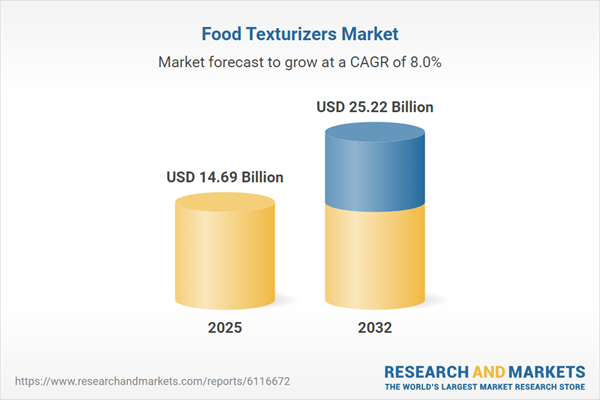Speak directly to the analyst to clarify any post sales queries you may have.
The food texturizers market is evolving rapidly as industry leaders prioritize advanced ingredient solutions to enhance product quality, adapt to regulatory changes, and meet shifting consumer expectations. Food manufacturers are leveraging texturizers to gain a competitive edge in formulation consistency, shelf-life optimization, and sensory appeal.
Market Snapshot: Food Texturizers Industry at a Glance
The Food Texturizers Market grew from USD 13.67 billion in 2024 to USD 14.69 billion in 2025. It is expected to continue growing at a CAGR of 7.95%, reaching USD 25.22 billion by 2032. This trajectory reflects sustained investment in innovation, supply chain adaptation, and rising demand for advanced food texture solutions worldwide.
Scope & Segmentation of the Food Texturizer Market
This report offers a comprehensive examination of the food texturizer sector, providing deep insights into market segmentation, technology adoption, and geographic trends.
- Type: Emulsifiers (Lecithin, Mono And Diglycerides, Polyglycerol Esters, Sorbitan Esters), Hydrocolloids (Carrageenan, Gelatin, Guar Gum, Pectin, Xanthan Gum), Starches (Modified Starch, Native Starch)
- Source: Corn, Potato, Tapioca, Wheat
- Form: Gel, Liquid, Powder
- Function: Emulsifying (Oil in Water, Water in Oil), Foam Stabilizing, Gelling (Heat Irreversible, Heat Reversible), Stabilizing (pH Stability, Thermal Stability), Thickening
- Application: Bakery, Beverages, Confectionery and Ice Cream, Dairy and Frozen Desserts, Meat and Poultry, Sauces and Dressings
- Geographic Coverage: Americas (including North America and Latin America), Europe, Middle East & Africa (EMEA), and Asia-Pacific, encompassing a wide array of regional markets and sub-regions
- Company Profiles: Covers leading global players such as Cargill, Ingredion, Tate & Lyle, Archer-Daniels-Midland, Kerry Group, DSM, Roquette, and others critical to the market ecosystem
Key Takeaways for Decision-Makers
- Ongoing focus on clean-label and plant-based formulations is shaping product development and influencing sourcing strategies across multiple regions.
- Technological innovation, including multifunctional ingredient solutions and digital supply chain tracing, is enabling more efficient product formulation and compliance with evolving regulatory demands.
- Manufacturers are adopting nearshoring, supply chain diversification, and local production hubs to address new tariff environments and minimize risk.
- Regional differences in regulatory frameworks and consumer preferences demand tailored approaches to product development, ingredient selection, and documentation standards.
- Strategic alliances and collaborative initiatives, both within the supply chain and with technology partners, are enhancing market adaptability and supporting sustainable innovations.
Tariff Impact on Global Food Texturizer Supply Chains
The introduction of new tariffs in the United States in 2025 has prompted market participants to rethink procurement and sourcing models. Companies that once depended on cost-effective imports have shifted towards local alternatives and diversified their supplier base. Increased emphasis on nearshoring and domestic manufacturing, as well as new alliances for quota management, has contributed to elevated resilience in the face of changing trade policies. These adjustments have also encouraged cost optimization through ingredient substitution and vertical integration initiatives.
Methodology & Data Sources
Findings are generated through a robust combination of secondary research—including trade publications, regulatory filings, patent analysis, and peer-reviewed journals—and direct expert interviews with senior executives across procurement, R&D, and market strategy functions. Data triangulation and stringent quality assurance protocols underpin all conclusions and analyses within this report.
Why This Report Matters
- Empowers decision-makers with actionable insights into critical trends and disruptive factors shaping the food texturizer landscape.
- Supports go-to-market strategies with region- and application-specific intelligence, helping adapt to both global and local challenges.
- Facilitates strategic planning by illuminating technology advances, regulatory trends, and growth opportunities tailored to end-user priorities.
Conclusion
This report equips industry leaders with the knowledge to drive innovation, improve operational strategies, and strengthen their competitive position within the food texturizers market. It provides a roadmap for navigating evolving regulatory, technological, and market dynamics.
Table of Contents
3. Executive Summary
4. Market Overview
7. Cumulative Impact of Artificial Intelligence 2025
Companies Mentioned
The companies profiled in this Food Texturizers market report include:- Cargill, Incorporated
- Ingredion Incorporated
- Tate & Lyle PLC
- Archer-Daniels-Midland Company
- Kerry Group PLC
- Royal DSM N.V.
- Roquette Frères S.A.
- Ashland Global Holdings Inc.
- Ettlinger Corporation
- SMScor
- PB Leiner
- Panier des Chefs
- Adinal
- Omya International AG
- Israel Chemicals Ltd.
- Hydrosol GmbH Co. KG
- Imerys S.A.
- Ceamsa
- Foodcom S.A.
- CelluForce
- Ecovia Bio
- Chrester Enterprises Ltd
- Schilling Ltd.
- Culinaide
Table Information
| Report Attribute | Details |
|---|---|
| No. of Pages | 180 |
| Published | November 2025 |
| Forecast Period | 2025 - 2032 |
| Estimated Market Value ( USD | $ 14.69 Billion |
| Forecasted Market Value ( USD | $ 25.22 Billion |
| Compound Annual Growth Rate | 7.9% |
| Regions Covered | Global |
| No. of Companies Mentioned | 25 |









